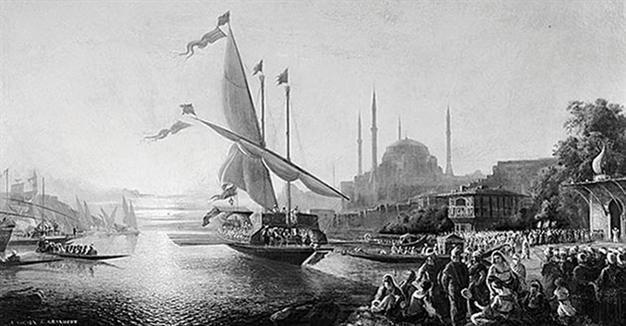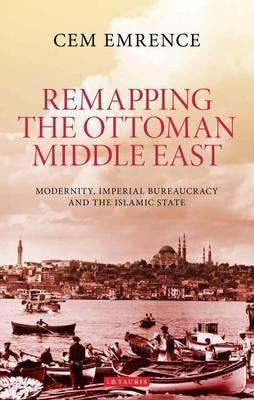INTERVIEW: Cem Emrence on three Ottoman paths to modernity
William Armstrong - william.armstrong@hdn.com.tr

'The arrival of a galley at the foot of the Hagia Sophia, Constantinople' (1890) by Pierre Emile Gigoux De Grandpré.
With the centenary of the First World War and the current turbulence in the Middle East, the fall of the Ottoman Empire has been receiving more attention in recent years.
“Remapping the Ottoman Middle East: Modernity, Imperial Bureaucracy and Islam” by scholar Cem Emrence (reviewed in HDN
here) is an original look at the longer process of Ottoman modernization that came to an end with the empire’s collapse. Unlike popular “unified” theories of causes for modernization, Emrence describes a model of “three-trajectories”: The coast, the interior, and the frontier, which each followed distinct paths to modernity.
Emrence spoke to the Hürriyet Daily News about what his work can teach us about the Ottoman Empire, Turkey, and the wider region today.
 Your book focuses the Ottoman Empire’s modernization in the 19th century. Could you give a basic overview of the three-trajectory model that you apply?
Your book focuses the Ottoman Empire’s modernization in the 19th century. Could you give a basic overview of the three-trajectory model that you apply?
I suggest that the Ottoman Middle East was characterized by three regional trajectories: The coast, the interior and the frontier. These trajectories represented distinct routes to state centralization on the one hand and economic integration on the other.
The coastal trajectory primarily means Western Anatolia and the East Mediterranean littoral. These regions were characterized by global economic flows and they were under the leadership of non-Muslim middle classes. In the interior - which included Anatolia, Syria and Palestine - it was a different story. Ottoman state building efforts were at the center of these regions’ transformations and a Sunni Muslim bloc held the leadership position. In the frontiers - Iraq, the Arabian Peninsula and Eastern Anatolia - geopolitical competition played a central role. Rural and religious leaderships were instrumental in terms of organizing public life and these regions evolved around the idea of local autonomy.
The key idea is that these were not simply geographical regions. They were socio-economic orders, or what I call “historical trajectories.” They were made by local actors on the one hand and structural forces on the other.
How is this model original and how does it differ from previous historiographical approaches?
Let me talk about how the field of Ottoman-Turkish studies and historiography has evolved over time. Very simply, there were three different approaches. Firstly, there were monocausal accounts. The idea here was to understand late Ottoman history in terms of Westernization, capitalism, or state-building. But in fact all these forces played a role in Ottoman history at the same time, and none of these models included the role of these three forces at the same time.
Another approach was a state-centric analysis, which is more popular in the popular imagination. The idea here was that the Ottoman state or the great powers or nation states are central in understanding late-Ottoman history. But these accounts are primarily about the intent, vision, or perspective of state leaders, rather than the practical application of policies. They do not talk about what was actually happening on the ground. They are mostly about what state leaders thought, envisioned, or tried to accomplish.
Another approach includes the "center-periphery" models, which I think have been the most influential. These were primarily about binary outcomes, with local actors either cooperating with the central state or conflicting with it.
I tried to come up with an account that addresses inter-empire differences: How did different regions in the Ottoman Empire evolve differently through the 19th century. The idea was to explain variation within the Ottoman world by taking into account multiple causes and multiple outcomes. This helps us understand differences within the Middle East and how the modern Middle East evolved differently.
So rather than having a single, homogenous explanatory theory of modernization and change, your approach tries to include the sheer variety of socio-economic conditions in the late Ottoman Empire.
We have to take into account the fact that capitalism played a role, Ottoman state-building played a role, and geopolitical competition between great powers and regional forces played a role. All these forces resulted in different trajectories. For example, in the frontiers it wasn't capitalism and the world economy but rather great power intervention and competition that influenced historical outcomes. On the coast, however, it was the world economy. In Syria, meanwhile, the story is about neither of these forces, but rather about Ottoman state-building. So I try to come up with a multi-causal account that includes all these forces and explains why we ended up with different types of societies across the region.
Do you think the model is applicable in a longer term? I’m particularly thinking of the Kurdish-majority areas in today’s Turkey as kind of “frontier” regions.
The longest continuity we can observe is in the frontier. One major continuity is the use of rebellion or armed resistance as a claim-making strategy - from Yemen to Eastern Anatolia to Iraq. In the case of the Kurdish issue and Kurdish resistance, I think there are more interesting comparative lessons that we can draw. The most important point here is that it was in the 1890s that the region - as a near-frontier region - was divided between religious and ethnic networks. In the 1890s the divide was primarily between Islam and Armenian nationalism. Today the divide is between Islam and Kurdish nationalism. The state survives but it has a serious legitimacy deficit.
Why do we observe these competing rival networks? Partly the reason is that the state tried to use both cooptation and transformation strategies together. This "inbetweenness" - not really deciding or having the capability to go from cooptation to transformation - results in a situation where the state is caught between a rock and a hard place. With cooptation you need to have friends, which means you will also have foes. You have to come up with strategies that divide the region. The policies that the state implemented - like special administrative regions - restructured the region. In that respect, policies that were decided in the 1890s have shaped the region up to now.
It is particularly interesting how in the frontier region during the 19th century the Ottoman state turned to this moral, religious agenda, emphasizing shared Sunni Islam to try to gain legitimacy where the grip of state institutions was weak. This has obvious echoes today with the ruling AKP’s strategy in Turkey’s Kurdish-majority areas, where it relies on overarching Islamic identity in the face of rebellion.
Certainly that is also what I had in mind. Typically, the region's history always involved both cooptation and transformation. By around the year 2000 the state and the government concluded, because of its own political priorities, that it had to go back to cooptation agenda, with religion playing a fundamental role. From just a basic survey one can conclude that there has been a concerted effort to use Islamic symbols and rituals to combat the ethnic Kurdish movement at several levels.
Is there any reason to believe this policy will be more successful today than it has been in the past?
I don't know the answer to this question. What we know from late Ottoman history and what we have seen so far in this latest episode is that both of them ended with war, unfortunately. One side defeats the other through war, displacement and similar strategies. So I'm not sure if propaganda and a cultural approach alone would be enough to defeat an ethnic movement.
What about this idea you describe of different post-Ottoman states each incorporating the three different trajectories within single countries, which is true for Turkey as well as elsewhere. The implications may be quite big, perhaps explaining the "legitimacy deficit" that people talk about regarding states in the Middle East today. What are the long-term effects of these different historical trajectories being incorporated within single states?
As I mentioned, strong continuities existed in the inter-war period in different Middle Eastern states, where a struggle started between political centers and different regions. These political struggles correspond to different trajectories. In the Turkish case there was strong political resistance from İzmir. The largest political opposition in terms of unarmed mobilization came from Western Anatolia, part of the coastal region. On the other side, there was armed opposition in Eastern Anatolia that corresponded to a near-frontier. There were similar forces in Syria, such as the rivalry between Damascus and Aleppo and the situation with the Druze. In the Arabian Peninsula, there was conflict between Riyadh and the Hijaz. In the end, by the 1930s political centers won the contest using force and other means.
But this begs the counterfactual question: What would have happened if political centers tried to negotiate with these regions and came to some kind of agreement? In the long run there would have been two options. In the positive scenario, it could have led to more power-sharing. In the negative scenario, it could have led to a more fragmented and polarized society in each Middle Eastern state. You could end up with a place like Switzerland with diversity but general agreement on certain things. Or you could end up like Kosovo or Sudan, which might lead to secession. Or you could end up like Lebanon, where everyone sticks to their own identity and the differences become unbridgeable.
So in the short run more negotiation and leniency towards regions could have worked perfectly. But in the long run, without solving the question of what is the common ground holding societies together, having and acknowledging differences does not automatically mean we will all live happily ever after.
*Follow the Turkey Book Talk podcast via iTunes here, Stitcher here, Podbean here, or Facebook here.

 Your book focuses the Ottoman Empire’s modernization in the 19th century. Could you give a basic overview of the three-trajectory model that you apply?
Your book focuses the Ottoman Empire’s modernization in the 19th century. Could you give a basic overview of the three-trajectory model that you apply?